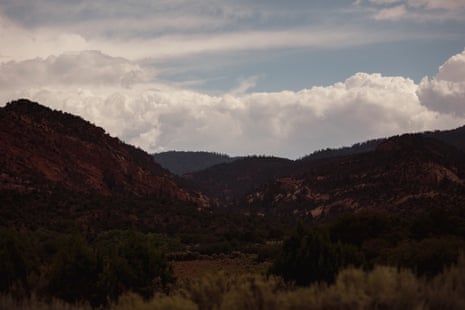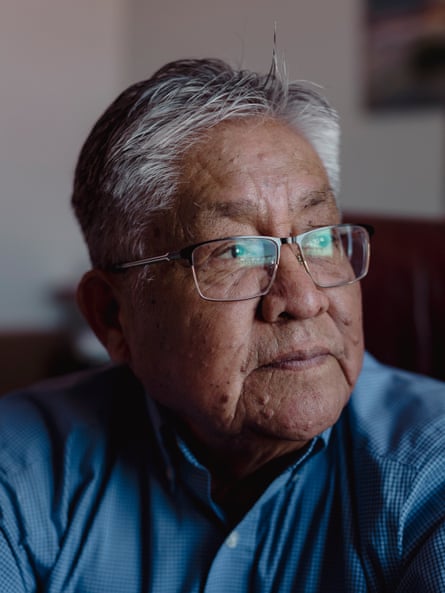Allen Tsosie was just 14 when he went to work in the uranium mines in the Lukachukai mountains near Cove, Arizona.
Tsosie was one of thousands of Navajos who took jobs in the mines, starting in the 1940s. They worked without masks or ventilation to disperse the lethal radon gas, and they were never told the rocks they were handling – leetso in the Diné language, or yellow dirt – were deadly.
In Cove, “you see a lot of women and children,” said Kathleen Tsosie, Allen’s daughter, because hundreds of men who worked in the mines have died.
Between 1944 and 1986, miners excavated nearly 30m tons of uranium ore – material used to develop nuclear weapons – from the Diné homelands, which spread across north-west New Mexico and north-east Arizona, and a sliver of southern Utah. These workers developed respiratory illnesses like lung cancer, pulmonary fibrosis and silicosis at alarming rates.
Allen, who worked in the mines for three decades, was among the victims: he died of lung cancer in 1985, at age 47.
Now, nearly 40 years after the last mine in Navajo country closed, former miners and other members of the Diné community who were exposed to uranium are fighting to get the radioactive waste cleaned up and to get fair compensation for those who have been sickened.
In July, the US Senate voted to expand the 1990 Radiation Exposure Compensation Act (Reca), which is set to expire next year. The original version of the law doesn’t cover those who worked in the industry after 1971 and offered limited coverage to downwinders – people who lived near nuclear weapons test sites or the mines. But if the expansion passes as part of a larger defense spending bill, advocates say it offers life-changing compensation to those who helped build the US’s nuclear arsenal and lived amid its toxic waste.
The Guardian spoke with Diné miners and the children of miners about the deadly legacy of the uranium boom.

Fighting for restitution: Phil Harrison
Harrison grew up near Cove, one of the most concentrated areas of uranium mining on the Navajo Nation. At night, he said, you could see the flickering of hundreds of miners’ campfires up in the mountains, “like little towns”.
Harrison, whose father died of lung disease in his early 40s, has advocated for uranium workers since the 1970s. He worked briefly underground during high school, joining his father in the mines. Later Harrison worked in Tuba City, Arizona, as a surveyor at a shuttered mill while the site was being remediated.
He helped to pass the original and also draft the proposed amendment, and has led delegations to Washington to lobby for it.
As it stands, miners, millers and truckers exposed to radiation can apply for a one-time, lump-sum payment of $100,000 as compensation, and downwinders can receive $50,000. But according to Harrison, Reca protections are far too narrow. Downwinders in parts of Arizona, Utah, and Colorado can apply; but those who lived just across the border in New Mexico – where the first atomic bomb was built and tested – cannot. Nor can those who worked in the mines or mills after 1971.
Harrison himself has been treated for kidney disease, but he isn’t eligible for restitution: his time underground was too short, and remediation workers aren’t covered.

The amendment would allow post-1971 workers to apply, expand the list of diseases and job categories eligible for compensation, and would provide larger payouts. It would also vastly expand the borders of downwind territories.
Harrison also works as a patient advocate for a home health care company that serves former uranium workers through a Department of Labor program, helping them access home nursing and medical equipment. These services are life-saving for the Diné, three-quarters of whom experience food insecurity and otherwise struggle to get the care they need.
“The majority of our people were uneducated and couldn’t read,” Harrison said. They took jobs in the mines, unaware of the danger and thinking they would be supporting their families – but now, he said, “people are pinching pennies to make it to their medical appointments”.
During a lobbying trip to Washington in July, Harrison said: “It is imperative that this amendment be made as soon as possible. We have lost a lot of people already.” Many more were waiting for funds to pay for medical care – people like Leo Martin, a former remediation specialist who had been diagnosed with advanced kidney disease.
In August, Martin told the Guardian he planned to apply for compensation if the amendment passed. In early September, he died.
‘We were poisoning ourselves’: Lena Dick Cason
Lena Cason remembers how her father would bring home jugs of cold water that he collected on the job, while working in uranium mines in the 1950s and 60s. It seemed like an easy perk of the industry: deep underground, along the ridge of a mountain range not far from Cason’s childhood home, cold water spilled down the walls of the caverns where her father and other men labored. “The water was so cool in the mines,” Cason said. “We thought it was delicious, but we were poisoning ourselves.”

Natural spring water is a precious resource for the Diné, 40% of whom still lack running water at home. The water her father brought home was used not just for drinking, but for laundry. Cason helped her mother washed her father’s work clothes in steaming tubs of mine water, which reeked with a sharp, metallic smell of uranium.
She still marvels that mine workers weren’t warned against using the radioactive water. The mining companies “knew how dangerous it was, but they made no effort whatsoever to protect the people and the families”.
Under a stormy sky in August, Cason stood outside her childhood home in the Red Valley, on the Arizona side of the Navajo nation. The house had been abandoned for many years, but the three apricot trees her parents had planted still grew in the front, and the playhouse her father built for the children out back was still there too.
Cason’s father died of lung disease at age 43. Cason, who is 70, was treated for stomach cancer 10 years ago and last year had surgery to remove a brain tumor. She has lingering pain and a tremor in her hand. She has been getting physical therapy to help her regain strength and mobility, but she isn’t eligible for home health care – those services are for uranium workers only, not downwinders. If the Reca amendment is passed, she would be able to get physical therapy at home, and a payout to make up for years of lost work.
When medical bills pile up: Kathleen Tsosie
At age seven, Kathleen Tsosie was already helping her grandmother herd sheep in the Red Valley, near Cove, Arizona. In summer, they moved their flock up into the Lukachukai mountains, where the air was cooler. When Tsosie was free to play, she and her friends scrambled over the piles of discarded uranium ore in their games. Her family, too, drank water from underground, and she remembers trucks rumbling through carrying ore, uncovered, to transfer stations and mills near and far.

Tsosie was diagnosed with breast cancer in 2007, when she was 47; four of her five sisters and her mother also had breast cancer. As a downwinder eligible for Reca, Tsosie received $50,000 in restitution. But chemotherapy and radiation treatments – and the loss of her job as a school aide when the side-effects of these treatments became unmanageable – drained those funds. When money ran out, she had to quit making the trip to Albuquerque for doctors’ appointments.
Tsosie joined Harrison’s delegation to Washington in July to lobby for the Reca amendment. If it passes, she would receive an additional $100,000, which would allow her to pay her outstanding medical bills. But she didn’t make the trip for herself, she said; she did it for “all my people”.
A month after the trip, Tsosie said she had doubts that the bill would pass. In the meantime, she said: “I thank my Creator every day that I get to see the sunrise.”
In March, the Environmental Protection Agency proposed adding the Lukachukai mining region where she played as a child to the Superfund list.
Dealing with chronic illness, and grief: Albert Lee
Nearly 50 years ago, along the eastern edge of the Navajo nation near Shiprock, New Mexico, Albert Lee built a one-room house for his family. Frugal by necessity, Lee repurposed materials that were plentiful and free, gathering sand from the abandoned uranium mill down the road, which he then mixed into concrete to build a sturdy foundation.
Lee had worked in the mines but like others, he labored without safety gear and received no warnings. “The government never told them what uranium can do to them down the road,” Lee’s son Robert said.
These days Lee, 83, rides a mobility scooter and is tethered to an oxygen tank (both courtesy of a local home health care company). He has pulmonary fibrosis and can’t walk more than a few steps without wheezing.
In late July, Albert and his wife, Helen, buried their daughter Cheryl, who died just weeks after she was told she had cancer in her lungs, kidneys and pancreas. The family suspects that uranium was to blame.
Albert has received a Reca payment, but Cheryl, because she didn’t live in a specified downwind county during the law’s narrowly drawn dates, was not eligible.

The Shiprock mill, where Albert found abundant sand to build his house with, was leveled in the 1980s. A chain-link fence topped with barbed wire surrounds a nearby evaporation pond; on the fence, a sign reads Yíiyá Bááhádzíd. “Danger: humans and animals must not drink the seep water.”
Around the time the site was remediated, Robert Lee said, officials from the Navajo Nation came around, asking about radiation exposure and saying they would return to test his parents’ house. If it was found to be hazardous, the family could be relocated. Then, he said, “they took all the documents, the pieces of paper, and they left”.
“The wind must have blowed through the car, and blew all the documents away,” Robert joked. “Nobody ever came back to see if we are contaminated.”
Almost 40 years later, the Lee family is still waiting for somebody to arrive with a Geiger counter.
مولدي العملات TikTok: النجاح والفشل
Legitimate Ways to Get Free Coins in LivU Video Chat
Where to Find Free Spins in Coin Master: Your Guide
Boost Your Avakin Life Avatar with Free Avacoins
Free Credits in Bingo Blitz: Insider Secrets
TikTok Coin Hack Myths Debunked
TikTok Coin Hack Myths Debunked
The Art of Earning TikTok Coins
Get Free TikTok Coins: The Ultimate Guide
Plongée approfondie dans la génération de pièces sur TikTok
TikTok Coin Generators: Fact vs. Fiction
Conseils de sécurité pour les générateurs de pièces TikTok
TikTok Coin Generator Review: What Works Best?
Ricompense in Monete TikTok: Ciò che Devi Sapere
Are TikTok Coin Generators Worth It?
Impulsa tu Cuenta de TikTok con Monedas Gratis
How to Get TikTok Coins Effortlessly
Free TikTok Coins Today: Quick Tips
Unlimited TikTok Coins: Myth or Reality?
El Impacto de las Monedas TikTok en tu Perfil
The Ultimate Game Changer: Free Coins in LivU Video Chat
What Every Player Should Know: Coin Master Free Spins Farming
TikTok Coin Farming: What You Need to Know
استراتيجيات النجاح باستخدام مولدي العملات TikTok
LivU Video Chat: Proven Strategies for Free Coins



